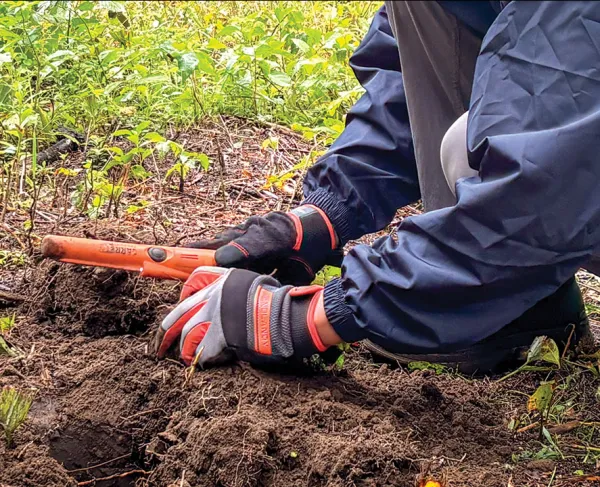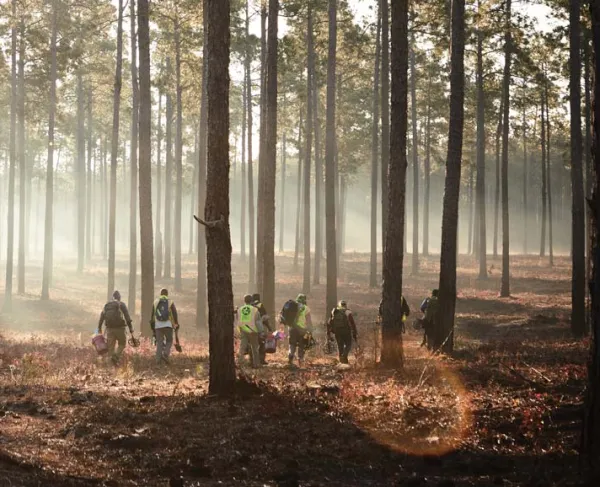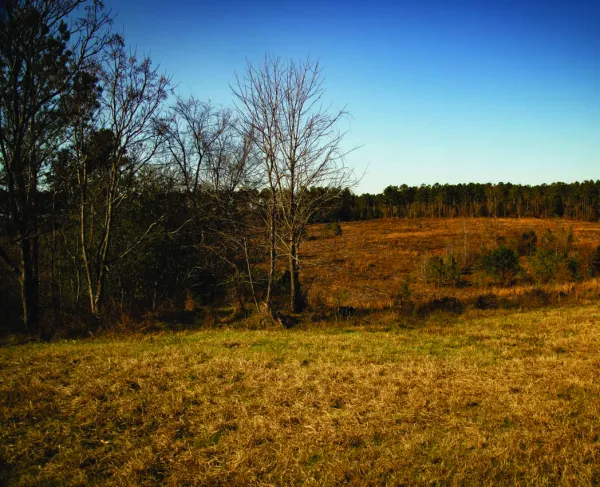Interview with Amy Bracewell & Stephen Humphreys
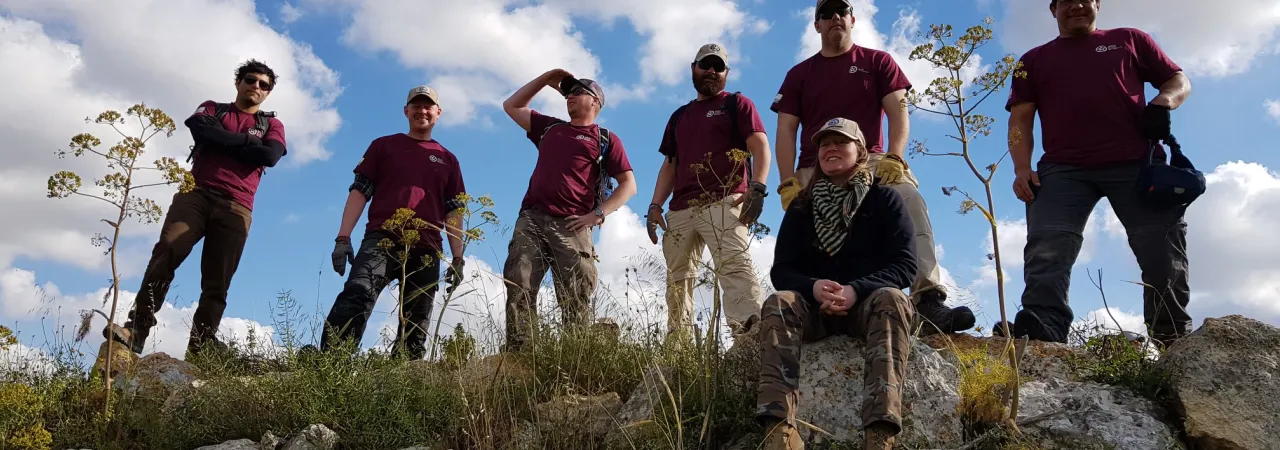
The Trust spoke with Dr. Stephen Humphreys, CEO at American Veterans Archaeological Recovery (AVAR), and Amy Bracewell, Superintendent at National Park Service’s (NPS) Saratoga National Historical Park, about the upcoming archeological dig at Saratoga involving both organizations.
The American Battlefield Trust and American Veterans Archaeological Recovery (AVAR) announced last fall a joint project with Saratoga National Historical Park to bring veterans together and utilize their unique skillsets to reveal buried secrets of American Revolutionary War history. Together, the nonprofit and National Park Service (NPS) will undertake an archaeological survey of the Barber Wheatfield, a historic site associated with the 1777 Saratoga battlefield, set for May and June 2019. The Trust discussed the significance of the dig and the role of the organizations with its leaders.
American Battlefield Trust: Dr. Humphreys, many of AVAR’s digs have been outside the United States. Why did AVAR pursue a project on an American battlefield?

Dr. Stephen Humphreys: One of our key elements of this 'Rehabilitation Archaeology' concept AVAR is pioneering is to expose American veterans to sites and projects that they will find interesting and relevant, where ever those might be. What we've seen is that the more they buy into the site, the more they take away from the project. American battlefields are places they understand and identify with.
How does it feel for veterans to be back on a battlefield?
SH: I think it's different for every individual, but what we tend to see is a sense of excitement as they realize that the skillset they received in the military is relevant to professional archaeologists. While veterans come from a variety of backgrounds in the military, the majority of those who sign up for AVAR digs have experienced combat; they bring a practical understanding of the terrain and the emotions involved in coming under fire that archaeologists lack. It all comes down to giving them a new way to see that even though they don't wear the uniform anymore, they are still useful and relevant.
Is there any significance to the project occurring on a Revolutionary War battlefield?
SH: The United States exists because a lot of people not so different from our AVAR participants risked everything on these fields two-and-a-half centuries ago, and we want to remind them that they’re still a part of that legacy. We want the site itself to help reinforce that sense of community AVAR is working to build. At the same time, we also think this is a site with a story that needs to be told. The engagement that took place on the Barber Wheatfields at Saratoga represents a turning point in the Revolutionary War and therefore an absolutely critical point in American history but it's an engagement we don't know a lot about from an archaeological perspective. Sometimes the archaeology tells a different story than the texts.
Why do military veterans turn to archeology?

SH: Military veterans are turning to archaeology because there are so many parallels between a dig and a military deployment or training mission. These aren't vacations we're taking our veterans out on. We expect our AVAR teams to accomplish the mission set by our academic partners, and to do it better than anyone else. Precision, attention to detail, and hard work are everything in this field, plus you have to be professional enough to work alongside people from a variety of backgrounds even when you're tired and covered in dirt. These are all things veterans have dealt with before, and frankly, a lot of vets miss the chance to excel in these types of conditions. We want to give them a chance to show that they've still got what it takes.
Is the work physically demanding? If so, does that play a role in its therapeutic effect?
SH: I think most people are surprised at how physically demanding excavations are. It varies a little from one site to the next but in general, about 80% of a dig is moving dirt with a pickaxe, a shovel, and a bunch of buckets and/or wheelbarrows, and the other 20% is fine detail work. When you find something it's because you've earned it. That difficulty is key for therapeutic impact. When you're trying to feel for buried walls and floors with every swing of your pickaxe you can't think about anything else. It takes intense concentration; you won't be thinking about bills, or emails, or whatever you have going on back home. A lot of our participants struggle with insomnia, but we find that 8 hours of digging will usually cure that. Plus, there's something about working hard alongside someone else that's doing the same thing that lets you know they'll be there for you when you need them. It's one of the things that bonds people together in the military and it works the same way on a dig.
What goes into preparing for these projects? Do participants learn about the history of the sites?
SH: We put an incredible amount of work into making sure our participants get the best experience possible on each excavation. We ensure there's a plan in place to handle any injuries or emergencies that occur in the field. Some digs generate these already so in these cases we just augment them with services specific to the veteran community; otherwise we build them from scratch. We also try to push as much information about the site as possible to our participants without it becoming overwhelming. For example, there's a great book on the archaeology of the battlefield at Saratoga (The Saratoga Campaign: Uncovering an Embattled Landscape) and we've recommended that to our participants. If they want to learn the site backwards and forwards we want to give them that option, but we also don't want them thinking they have to do all that prep-work just in order to show up on day one...some of these guys have full-time jobs and families and just don't have that kind of time.
The project is going to bring together roughly 30 participants. Would you highlight one or two vets and their experiences with the program?
SH: Most of the participants on this excavation will be new to AVAR and to archaeology, although I'd mention that one of our incoming Vietnam veterans had a distant relative who fought in both battles at Saratoga. However the second half of the project is oriented more towards the ‘back-end’ of archaeology, the report-writing and cataloging, so we wanted to give some returning participants who have dug with us and are looking toward careers in archaeology the chance to get some experience with that side of things. Zeth is a 27-year-old Army veteran with a deployment to Afghanistan who has worked with us already on projects in the United States and Israel. He is now pursuing an undergraduate degree in Archaeology, Technology, and Historical Structures at the University of Rochester. Kyle is a local Army veteran with deployments to Iraq and Afghanistan and an intense interest in the archaeology of New York. He also worked with us in Israel last year and we’re looking forward to catching up with him at Saratoga.

How do you determine if the program is successful for the veteran participants?
SH: Success for us means that a veteran participant makes a positive change in their own life as a result of working with us. We do have our participants take the Pain Assessment Screening Tool and Outcomes Registry survey (PASTOR) developed for the DoD, which measures both mental and physical impact, so we're doing the quantitative analysis necessary to show our program works and make improvements. However, we're dealing with people here, not numbers, and changing lives is a lot fuzzier and more challenging than showing that someone was happier at the end of the dig than at the beginning with an online survey. What we really look for is long-term positive change, and we see that because we stay in touch with our participants and vice versa. We’re vets too, so our participants are like family to us. If one of our participants who was previously isolated and spending most of their time on a couch starts a degree program after going on a dig, even if that degree isn't in archaeology, we call that a win. If one of our participants who is already employed as a commercial archaeologist gets another bullet on their resume that will help them move forward in their career, that's a win. If a vet who felt lost and alone, and was contemplating becoming one of those 22 who take their own life every day, comes out of a dig with a new group of people who have their back, that's a huge win.
Your participants will potentially play an active role in uncovering American history. Why is understanding our nation’s story so important?
SH: Our participants have already been active participants in writing our nation's story, so I think it's even more important that they understand where we as a nation have come from. It's also important that they understand how the facts get into the history books. With digs like this we're giving them a chance to touch the raw data before it's been interpreted or processed, and even to weigh in on those interpretations based on their experiences in combat. They're getting another chance to write our nation's story in a completely new way.
What does finding a relic from a previous conflict, in this case the Battle of Saratoga, mean for the veterans?
SH: I hope that it will give them a connection to those who have worn this country's uniform before. We had a team on a WWII airbase in England last year and that dig produced a number of American dog-tags, some of which came from Airmen who didn't make it home. Finding items like that reminds you that people have been fighting for American values for centuries and that even though we live in very different times, we have a lot in common where it counts. It reminds you that you're still part of something much bigger than yourself.
American Battlefield Trust: Superintendent Bracewell, how did you come into your role with NPS, at Saratoga?
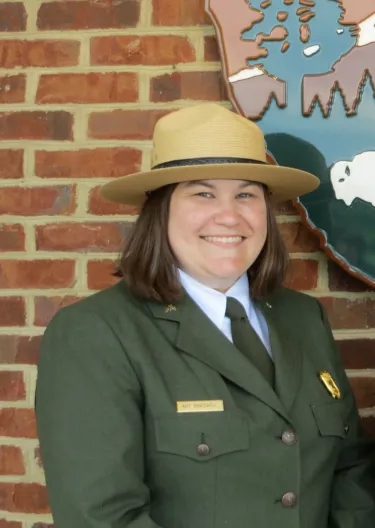
Amy Bracewell: I joined the National Park Service while still in graduate school. I found a career and agency that married well with my passion for public history, public service, and the preservation of our country's treasures. Through my personal journey with the National Park Service, I have loved the opportunities where I have been able to support and empower our park teams in providing the best public service possible. Through these experiences, I found I could do the most good while serving as the park superintendent at Saratoga.
Why did you partner with AVAR and the American Battlefield Trust on the site survey?
AB: For many years, we have wanted to tackle large landscape surveys of the battlefields to better understand the history and to potentially confirm troop locations and the sites of historic homes. We knew we would not be able to tackle this alone. When the American Battlefields Trust reached out to me with the interest to partner with AVAR, I knew this was our moment. This survey is embarking on a completely innovative approach to archeology, and what better partner than the American Battlefield Trust. The Trust has supported innovative research and land protection approaches since its inception. With AVAR on board, we are able to expand our abilities in battlefield archeology with veterans who understand intimately the nature of war. Our AVAR veterans cannot only gain new skills through this archeological work, but they will help us understand the language of American military actions, which was conceived on our Revolutionary War battlefields.
How will the project be conducted? Will the veterans make use of special tools?
AB: Our archeological survey this summer has never been tried before at Saratoga. Our National Park Service archeologists have created an innovative approach that will utilize the most current technology available. The threefold approach will begin with aerial LiDAR data captured by unmanned aircraft systems (UAS). While citizens are not allowed to fly UAS in national parks, we were able to get an exemption and a permit to collect scientific data for this project. The second phase of this project includes a multi-array system that is pulled behind an ATV. This multi-array can capture five or six different types of archeological data at one time, including ground penetrating radar. This multi-array is being utilized in partnership with our archeological colleagues in the Midwest Region of the National Park Service. The third phase of the project includes AVAR and on-the-ground reconnaissance. The team will start off in training on the use of highly sensitive metal detectors with instructors from the Advanced Metal Detecting for the Archaeologist (AMDA). With the use of these tools, our AVAR team will attempt to verify troop locations, as they are proposed on historic maps. Once their metal detecting data has been analyzed, traditional archeological methods, including test plots, will be utilized to confirm the initial investigations. All of the digital data will be synthesized with what the AVAR team will be finding on the ground, and will provide one of the most comprehensive views of the second battlefield that has ever been completed.
It seems like so much is known about the Battle of Saratoga. Can modern-day archeological work uncover things we don’t know about our collective past?
AB: Many scholars have written about the Battles of Saratoga, and have poured over excellent archival records from the battles. While we do have excellent records, and continue to acquire new information on regiments and personal histories related to the battles, we still struggle with confirming where exactly events took place on the landscape. Revolutionary War maps were remarkably detailed and provide a great deal of information, but they, unfortunately, lack in accuracy in regards to drawing perspective and actual landscape features. Through continual archeological investigations, we can better understand where exactly events took place. With modern technology, we are able to georeference the historic maps in ways we have never been able to do before.
Is there more land to save at Saratoga? How does the AVAR project fit into preservation needs?

AB: We have been extremely lucky at Saratoga since the majority of the core battlefield lands were preserved from the very beginning by then-Governor Franklin Delano Roosevelt when he set aside the site as a state park in 1927 on the sesquicentennial of the battles, and then eventually as a national park by President Roosevelt in 1938. Over the years, park management has been able to work with willing sellers and land preservation organizations, like the American Battlefield Trust, to further protect pieces of battlefield land. Most recently, the Friends of Saratoga Battlefield partnered with Open Space Institute and the Historic Hudson Hoosic Partnership to purchase and preserve the Surrender Site, where General Burgoyne became the first general in British history to surrender his army to the opposition. This land had been in private hands since the battles. The park also recently partnered with the American Battlefields Trust to secure land which was part of the Schuyler Estate and played a critical role in the Siege of Saratoga. Each piece of land tells its own story and helps historians put the pieces of the puzzle back together again, in order to better understand our collective history.
What result do you hope to see from the AVAR project?
AB: We hope to accomplish many goals with the help of AVAR. The first goal is to connect our veterans with sacred land through their involvement in this project. The veterans involved in this project have been impacted both mentally and physically by the horrors of war, and we hope that connecting with the hallowed ground at Saratoga may provide some peace. Our veterans also bring with them extraordinary knowledge and skills that they acquired during their time in service. We hope to be able to tap into their talents in order to better understand the history at Saratoga. Soldiers approach the landscape, and the challenges of war, with a much different lens than civilians. We hope to learn from our AVAR colleagues and what they might be able to glean from the archeological record. In terms of archeological goals, we hope that our ground investigations with the AVAR team help confirm some of the key signatures related to the second battle. Where might lines of fire been? Where exactly did the various regiments stand and move? This archeological investigation will hopefully shed light on the ground logistics of the second battle.
What do you hope participants will take from the project?
AB: This project is so meaningful to us at the park for many different reasons, and I hope the participants feel our excitement and passion for this resource and project. The Battles of Saratoga served as a turning point of the Revolutionary War. General Burgoyne surrendered. France joined the American effort because of our victory at Saratoga. A ripple effect of freedom made its way across every state and colony under Britian's control. I hope the participants are able to feel this significance in the work they will be doing, in the discoveries they may make, and in the reporting work they will leave for future generations to read one day. Their efforts are defining history here at Saratoga, and I hope the participants feel a great sense of pride in the public service they have not only given on their own battlefields, but here at Saratoga where our country's freedom began.
If objects are found, what happens next? Are they digitized? Will they be put in a museum?
AB: Saratoga National Historical Park has a robust and comprehensive curatorial collection related to the two battles. Only a small percentage of items are able to make it into the museum exhibits at the Visitor Center, but other artifacts have been cataloged and are analyzed by staff and scholars to better understand Saratoga's history. If objects are found during this archeological investigation, they will be recorded and documented to preserve their provenance and context on the battlefield. Archeologists are taking extreme caution with artifacts these days, as our current, and future technologies may be able to discern organic and metallurgic details from the surface of artifacts. Objects will be handled with care, and stored in a secure manner, so that future analysis can be made. Future plans for the artifacts could include digitization as well as the development of new exhibits, perhaps even in time for the 250th anniversary of Saratoga in 2027!
What do artifacts, from projects such as this one, tell us about the battle?
AB: Artifacts can share a great deal of information about history. Using highly skilled techniques for collecting and documenting archeological artifacts, our team would be able to not only potentially identify the specific troop or regiment that is associated with that artifact, but sometimes you can get as specific as an individual. The location of an artifact also shares a great deal of information. When you can analyze where an object is in relation to the landscape, or other objects, specialists can identify firing lines, or military camps, or even where a specific person may have fallen on the battlefield. In conjunction with archival maps, journals, and other first-hand reports, artifacts can confirm or correct the historical record. The location, provenance, context, and forensics of a particular artifact are equally as important as the object itself. New technologies are constantly being developed and utilized to glean DNA, bio-mater, and other forensic details from the surface of archeological artifacts.
What are you most looking forward to about this dig?
AB: I am most excited about getting to work with an amazing group of people. The staff at Saratoga has been blown away by the support and partnerships that have come in because of this project. We are expecting a small army of archeological specialists to convene at the park during this project, which will be an unbelievable experience for all of us. NPS archeologists will be helping from two regional offices and several neighboring parks. Instructors from the Advanced Metal Detecting for the Archeologist (AMDA) are volunteering their time to train and work alongside our AVAR team. Engineers and scientists are assisting the project with their skills and talents in analyzing technological data that will be collected during this project. And finally, the AVAR team will be working with our park's curator to catalog, organize, and document the artifacts and the field notes from the investigation. This enormous effort is no small feat and I am thrilled to be able to support these talented individuals who are all giving their time and skill to conduct this monumental project with the park.
